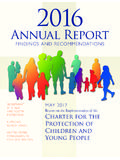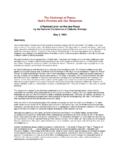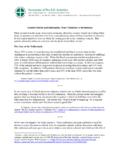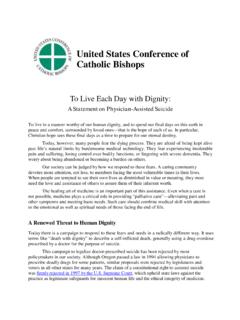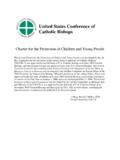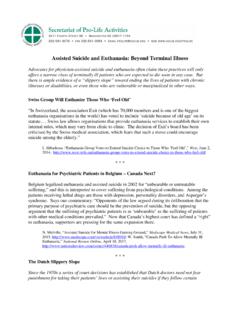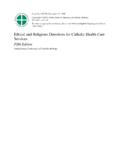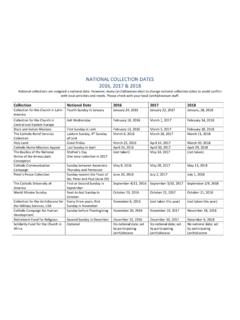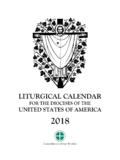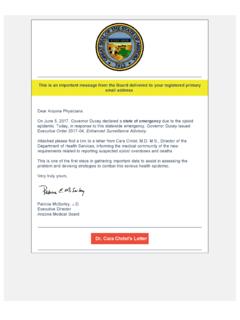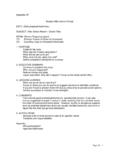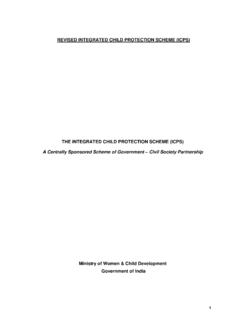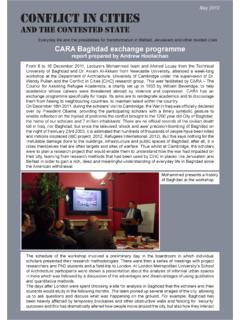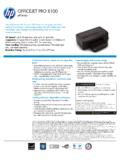Transcription of Ordination Class of 2017-FINAL - usccb.org
1 Center for Applied Research in the Apostolate Georgetown University Washington, DC The Class of 2017 : Survey of Ordinands to the Priesthood A Report to the Secretariat of Clergy, Consecrated Life &Vocations United States Conference of Catholic Bishops April 2017 Michal J. Kramarek, Mary L. Gautier, Table of Contents Executive Summary .. 1 Major Findings .. 2 Introduction .. 5 Part I: Ordinands to Secular (Diocesan) and Religious Priesthood .. 6 Part II: Age .. 8 Age When First Considered Priesthood.
2 8 Age When Scheduled for Ordination .. 10 Ordinands by Year of Birth .. 10 Part III: Selected Demographics .. 12 Race and Ethnicity .. 12 Country of Birth and Year of Entrance into the United States .. 14 Siblings and Birth Order .. 17 Part IV: Education .. 18 Highest Level of Education before Seminary .. 19 Attained Catholic Education .. 22 Participation in Catholic Religious Education .. 23 Home Schooling .. 24 Educational Debt .. 25 Part V: Work .. 28 Employment Background .. 29 Military Background .. 30 Part VI: Vocational Discernment.
3 32 Family Religious Background .. 33 Prayer Practices .. 35 Participation in Faith-Related Activities .. 36 Participation in Parish Ministries .. 38 Influence of Others .. 40 Participation in Vocation Activities .. 43 1 Center for Applied Research in the Apostolate Georgetown University Washington, DC The Class of 2017 : Survey of Ordinands to the Priesthood Executive Summary This report presents findings from a national survey of seminarians scheduled for Ordination to the priesthood in 2017 . The report is a part of collaboration between the United States Conference of Catholic Bishops ( usccb ) Secretariat of Clergy, Consecrated Life and Vocations and the Center for Applied Research in the Apostolate (CARA).
4 The purpose of this report is to compile information regarding men who are ordained to priesthood within a particular year. The data collection for this report involved identifying the responding ordinands to the priesthood in 2017 by contacting all theologates, houses of formation, dioceses, archdioceses, eparchies and institutes of men religious in the United States for the names and contact information of all men scheduled for Ordination to priesthood in 2017 . The resulting contact list was used to administer the survey.
5 The survey was administered between March 1 and March 29. The survey invitation was sent by email to 590 ordinands. Two follow-up emails were sent to the ordinands who delayed their response and one follow-up email was sent to major superiors and vocation directors asking for assistance with encouraging the ordinands to participate in the survey. Where email addresses proved incorrect, CARA contacted the respondent by telephone to request a response. A total of 444 ordinands completed the survey (75 percent response rate).
6 The responding ordinands included 343 ordinands to the diocesan priesthood (77 percent of all responding ordinands) and 101 ordinands to the religious priesthood (23 percent). 2 Major Findings Over three-quarters (77 percent) of all responding ordinands are preparing for Ordination to a diocese or eparchy. Responding ordinands from religious institutes comprise the remaining 23 percent. The biggest group of responding ordinands (one-third) studies at the seminaries in the Midwest. One in ten studies at a seminary abroad.
7 On average, responding diocesan ordinands lived in the diocese or eparchy for which they will be ordained for 16 years before they entered the seminary, while responding ordinands from religious institutes knew the members of their religious institute for six years before they entered the seminary. Age On average, responding ordinands first considered priesthood when they were 16 years old. On average, responding ordinands were scheduled for Ordination 18 years later (at the age of 34). Since 1999, the average age of responding ordinands has decreased by approximately two months each year, from an average of 36 in 1999 to the current average age of 34.
8 Selected Demographics The majority of responding ordinands is Caucasian (seven in ten) and was born in the United States (three in four). One in four is foreign-born. By comparison, since 1999, on average, each year, 29 percent of responding ordinands were foreign-born. The five most common countries of birth among the foreign-born are Mexico, Vietnam, the Philippines, Colombia, and Poland. On average, foreign-born responding ordinands came to live in the United States 12 years ago at the age of 25. Almost all responding ordinands (97 percent) have at least one sibling.
9 On average, responding ordinands have three siblings and they are most likely to be one of the middle children in the family. Education Less than one in ten (8 percent) of responding ordinands reported being home schooled; among those who were home schooled, they report seven years of home schooling, on average. Between 40 and 50 percent of all responding ordinands attended a Catholic school for at least some part of their schooling. Three in five responding ordinands (59 percent) participated in a religious education program in their parish for seven years, on average.
10 Two in five responding ordinands (43 percent) reported that they completed college or university undergraduate degree before entering the seminary. Responding ordinands from religious institutes had completed a higher level of education, on average, than responding diocesan ordinands prior to entering the seminary. 3 More than one in seven responding ordinands who attended undergraduate or graduate school before entering the seminary studied in one of the following fields: social science, theology or philosophy, business, or liberal arts.
